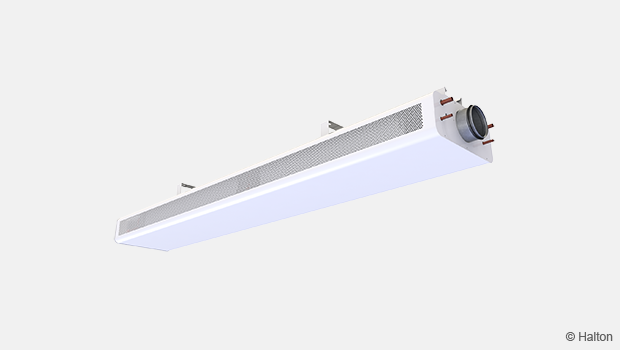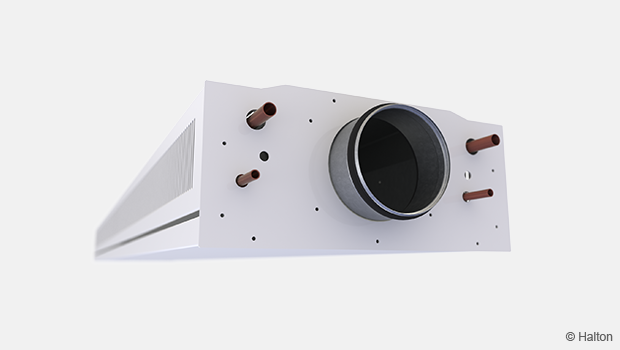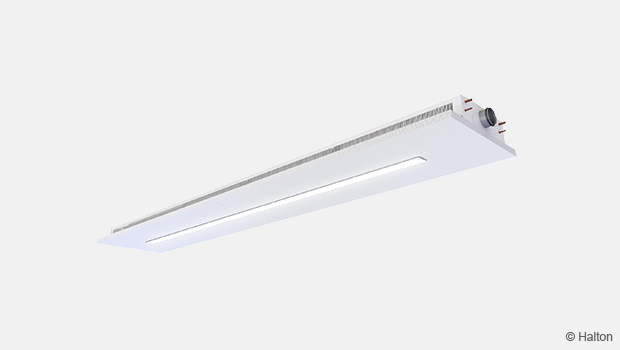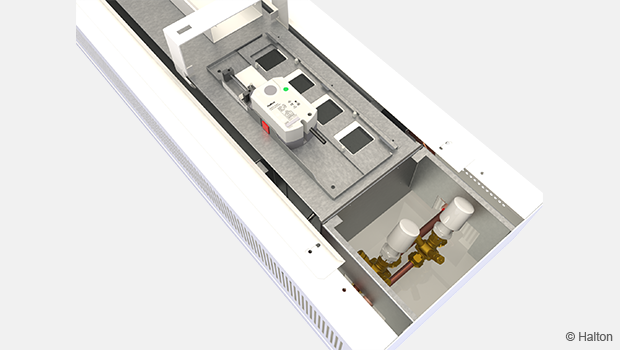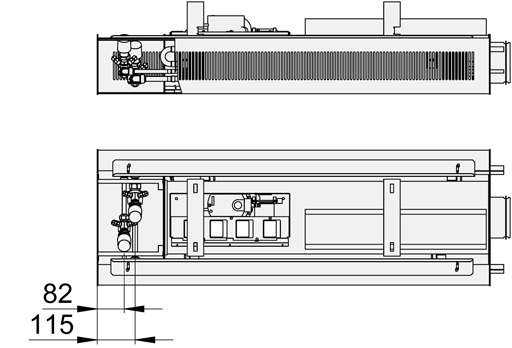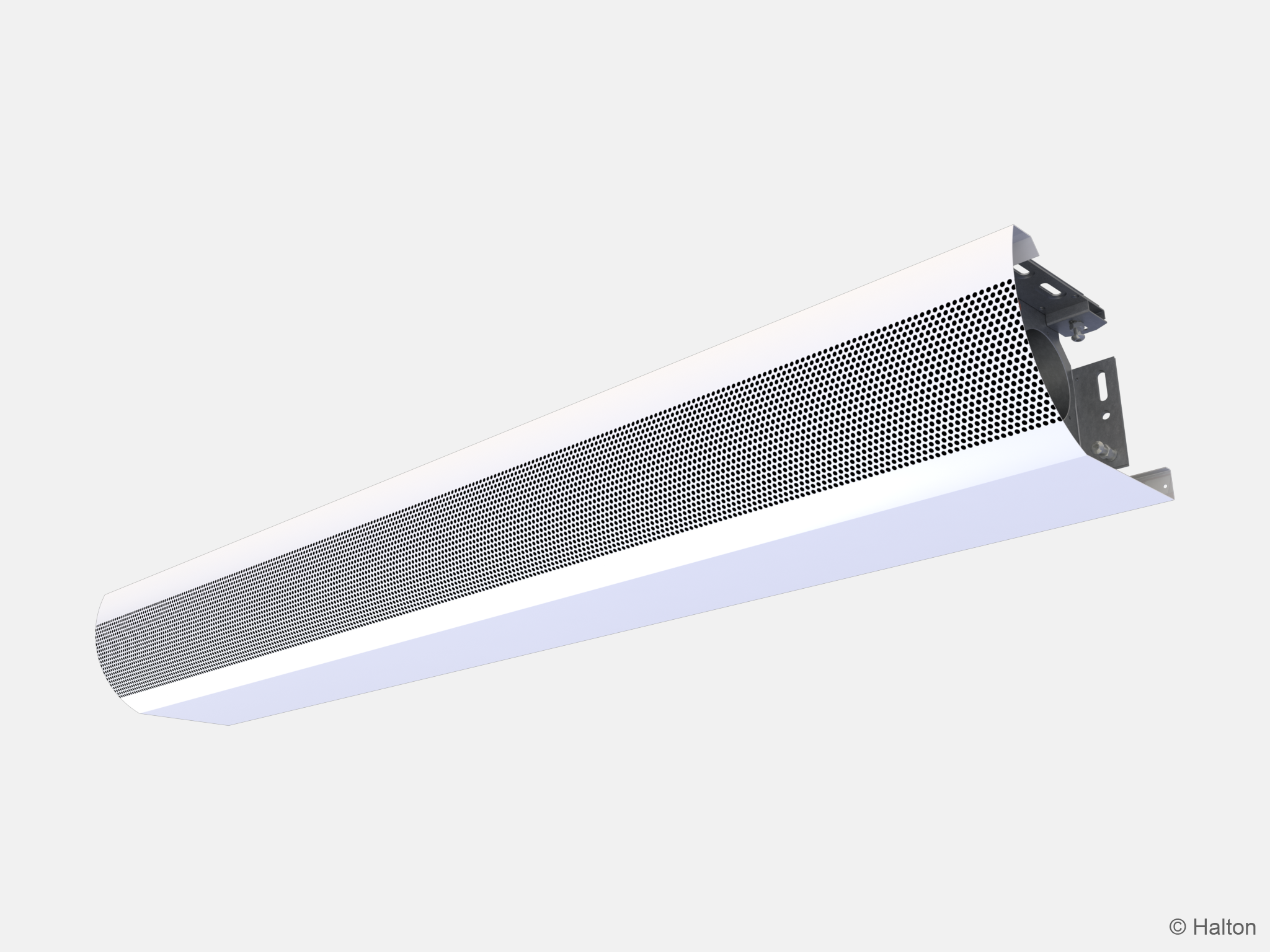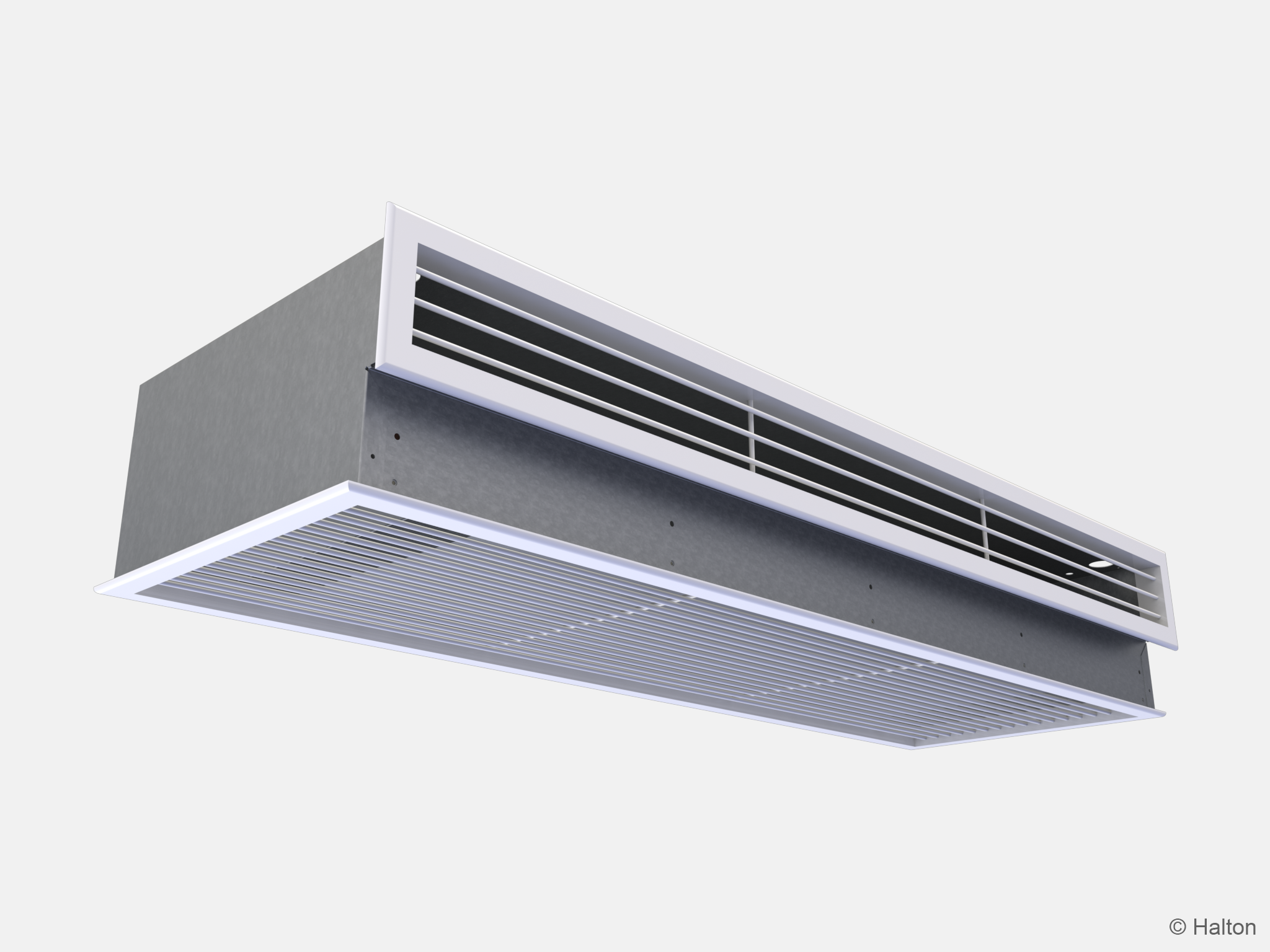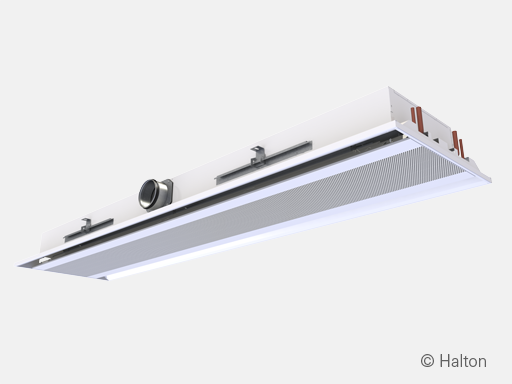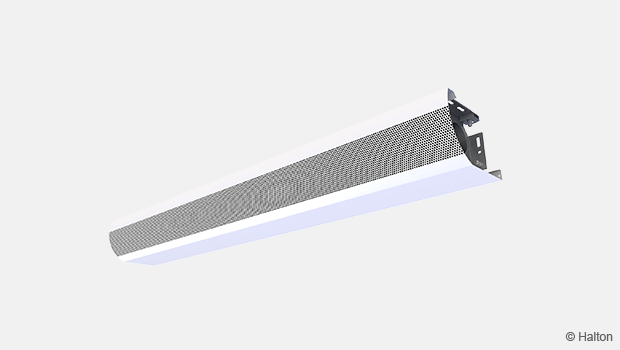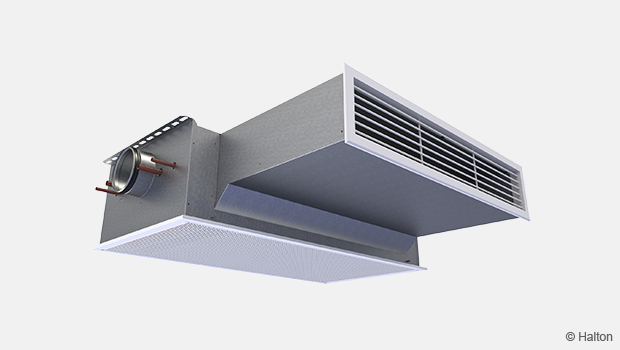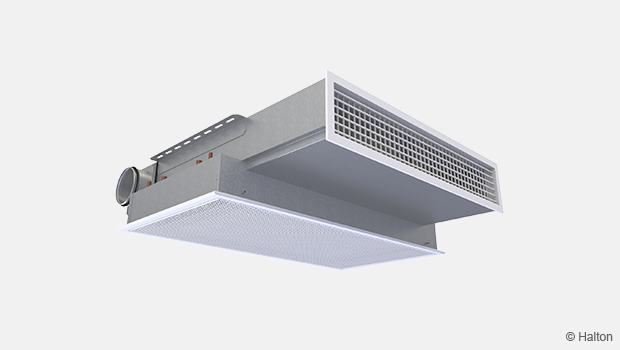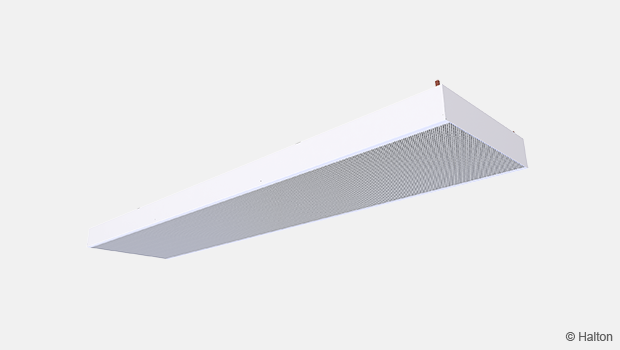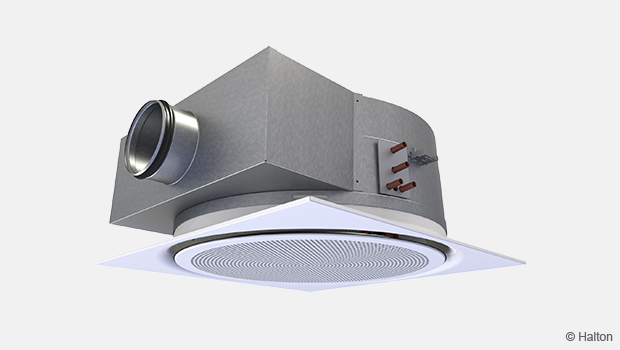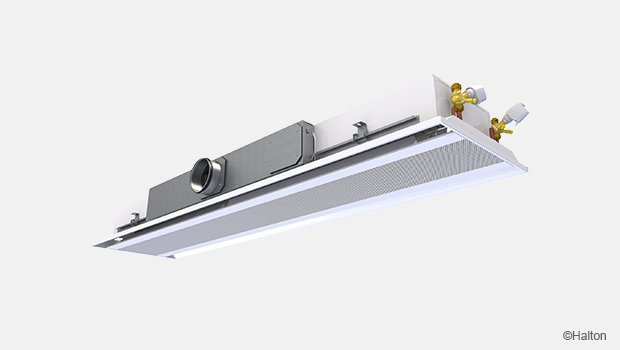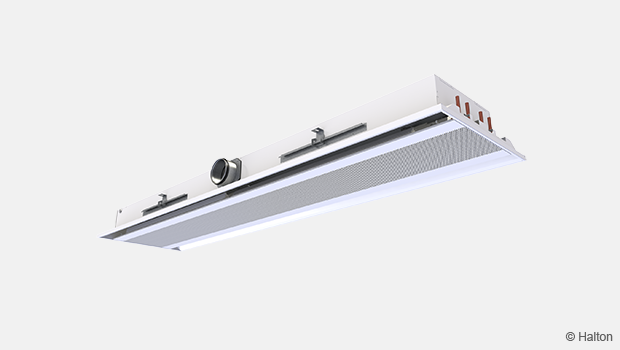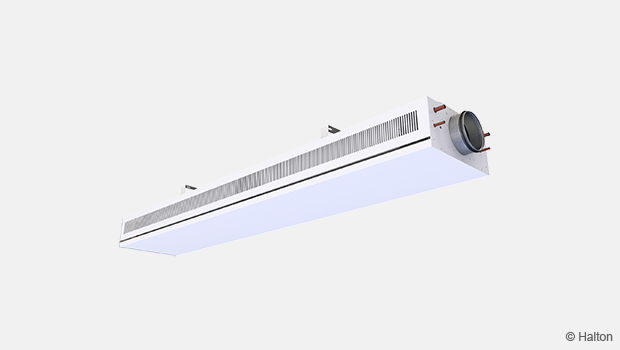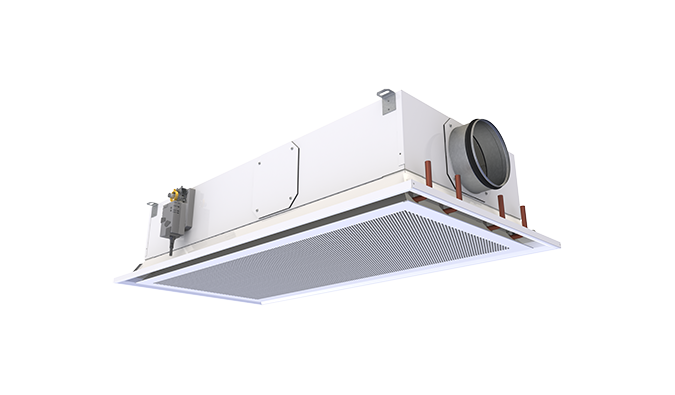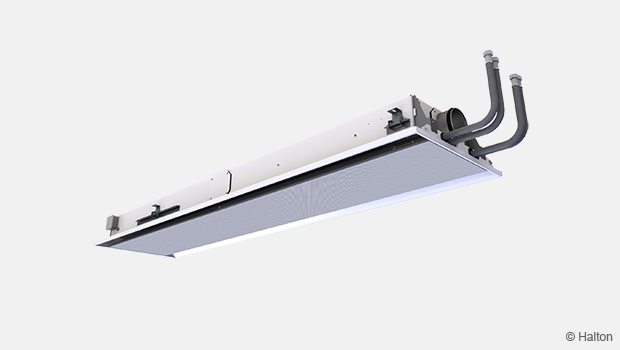Product / REE
Halton Rex REE – Chilled beam
Adaptable active chilled beam for exposed installation
- This active chilled beam is fully adaptable for customised design solutions.
- Sensors and lights are easy to integrate into the unit.
Overview
- Combined cooling, heating, and supply air unit for exposed installation
- In-built flexibility for easy and fast adaptation of operation during space layout and usage changes
- Individually adjustable velocity conditions with Halton Velocity Control (HVC)
- Adjustment of velocity conditions in case of partition wall relocations with HVC
- Adjustable supply airflow rate for layout changes with Halton Air Quality (HAQ) control
- Possibility to choose several different outlooks
Product models and accessories
- Model with combined cooling and heating coil
- Models with manual, motorised and retrofit HAQ
- Cable tray, duct cover, integrated control valves and actuators as accessories
- Model with Halton Workplace WRA room automation system package
Halton chilled beams are certified by Eurovent Certita.

Dimensions and weight
Connection types, air and water
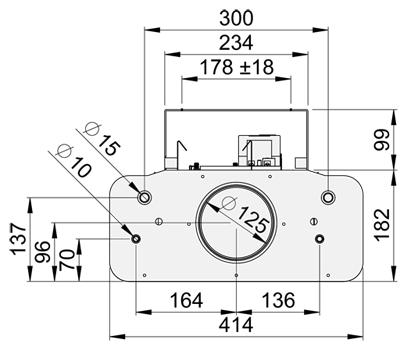
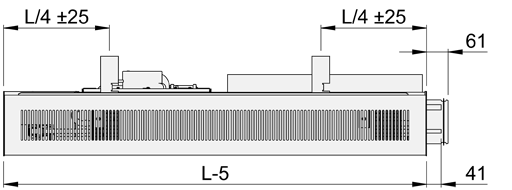
Fig.1. Air and water connections at the same end (CT= S)
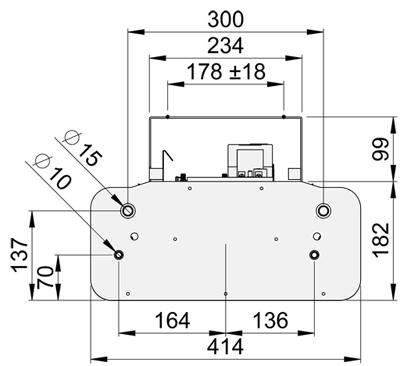
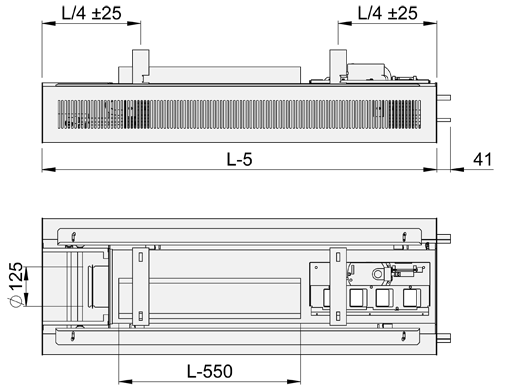
Fig.2. Water connections at the opposite end (CT=O)
| Length, L (mm) | 1200, +100, …, 4800 |
| Coil length (mm) | 900, +100, …, 4500 |
| Weight (kg/m, water excluded) | 16 |
Note:
The front panel of the chilled beam is divided into two equal sections in chilled beams longer than 2400 mm when visual appearance options are VA = RO, RR, AO or AR. For visual appearance VA = SO the front panel in always made of one section.
Valves
Cable tray
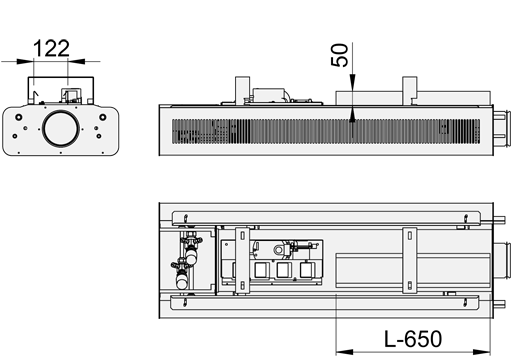
Length of the cable tray = 650 mm less than length of the beam.
Material
| Part | Material | Finishing | Note |
| Front panel | Pre-painted galvanised steel |
Polyester-painted white (RAL 9003 or RAL 9010, 20% gloss) |
Special colours available, polyester-epoxy-painted |
| Duct cover | Pre-painted galvanised steel |
Polyester-painted white (RAL 9003 or RAL 9010, 20% gloss) |
Special colours available, polyester-epoxy-painted |
| End plates | Galvanised steel |
Polyester-epoxy-painted white (RAL 9003 or RAL 9010, 20% gloss) |
Special colours available, polyester-epoxy-painted |
| Cable tray | Pre-painted galvanised steel |
Polyester-painted white (RAL 9003 or RAL 9010, 20% gloss) |
Special colours available. polyester-epoxy-painted |
| Supply air plenum | Galvanised steel |
– | – |
| Brackets | Galvanised steel |
Polyester-epoxy-painted white (RAL 9003 or RAL 9010, 20% gloss) |
pecial colours available |
| Coil pipes | Copper | – | – |
| Coil fins | Aluminium | – | – |
Cooling/heating water pipe connections are Cu15/Cu10 with wall thickness of 0.9-1.0 mm fulfilling the requirements of European Standard EN 1057:1996.
The maximum operating pressure for chilled/hot water pipework is 1.0 MPa @ 70 °C.
Accessories
| Accessory | Code | Description | Note |
| Combined cooling and heating coil |
TC = H | Coil with hot water circulation |
Cooling/heating copper water pipe connections are Ø 15/10 mm |
| Cooling coil with air bleeder |
TC = CV | Coil with chilled water circulation |
Cooling copper water pipe connection is Ø 15mm |
| Combined cooling and heating coil with air bleeders |
TC = HV | Coil with hot and chilled water circulation |
Cooling/heating copper water pipe connections are Ø 15/10 mm |
| Halton Air Quality control (HAQ damper) |
AQ = MA | Manual operation | Located in the non-connection end of the beam |
| AQ = MO | Motorised operation Power supply 24 VAC Control signal 0…10 VDC |
– | |
| AQ = RE | Reservation for retrofitting of HAQ |
In retrofitting, HAQ installation is possible afterwards. |
|
| Visual appearance | VA = See Order Code tab |
For appearance options See Fig. 1-5 |
Selected options have the same performance data and dimensions. |
| Control valves and actuators |
CV = see Order code tab |
See Control Valves and actuators below (table and Fig. 6.- 7.) |
Factory fitting available only if air and water connections are at the same end (CT=S) |
| Cable tray | AC = KH | Prepainted See Fig.8. |
Length of the cable tray = Beam – 650 mm |
| Duct cover | Subproduct, DCB |
Self-supporting cover plate. No need for installation brackets See Fig.9. |
Available as tailored solution. Please contact sales. |
Visual appearance options (VA)
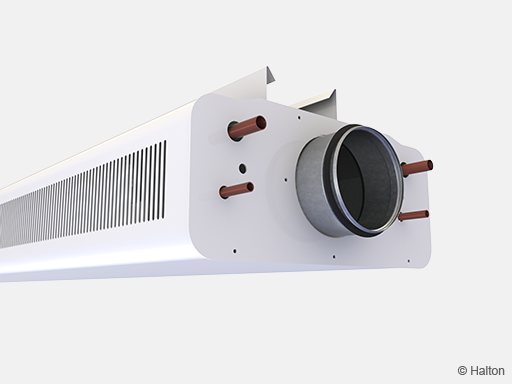
Fig.1. Rounded, oval perforation (RO)
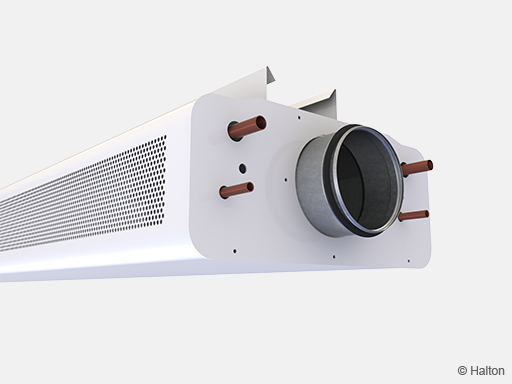
Fig.2. Rounded, round perforation (RR)
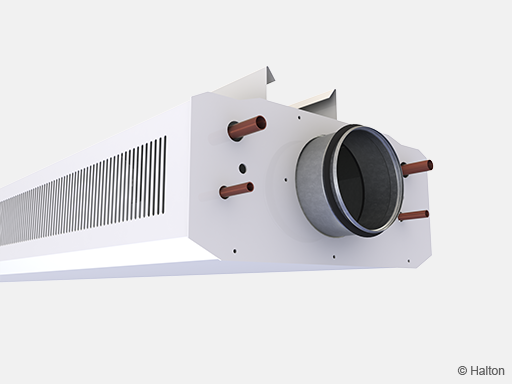
Fig.3. Angular, oval perforation (AO)
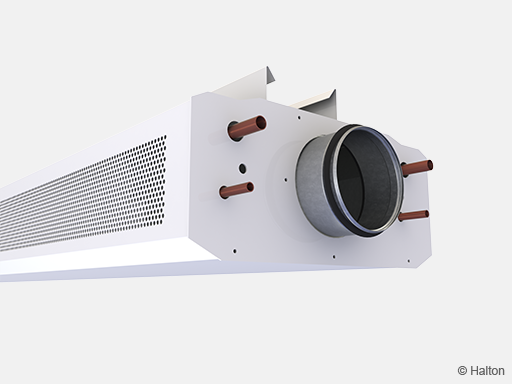
Fig.4. Angular, round perforation (AR)
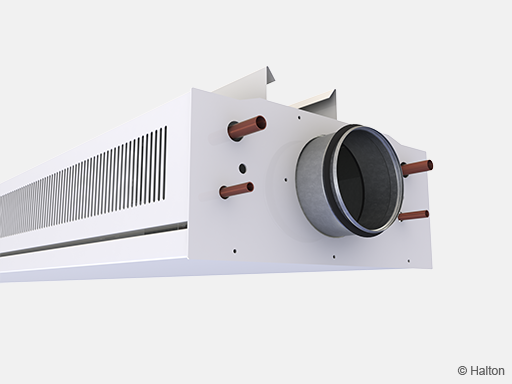
Fig.5. Square with fixed front panel, oval perforation (SO)
Control valves and actuators
| Code | Valve | Actuator | |||
| Name | Type | Name | Type | Voltage | |
| DR1 | RA-C | Adjustable kv value | TWA-A | N/A | – |
| DR2 | RA-C | Adjustable kv value | TWA-A | On/Off, normally closed |
24V AC/DC |
| DR3 | RA-C | Adjustable kv value | TWA-A | On/Off, normally closed |
230V AC |
| DA1 | AB-QM | Constant flow, with test plugs |
TWA-Z | N/A | – |
| DA2 | AB-QM | Constant flow, with test plugs |
TWA-Z | On/Off, normally closed |
24V AC/DC |
| DA3 | AB-QM | Constant flow, with test plugs |
TWA-Z | On/Off, normally closed |
230V AC |
Size of valve: Cooling = Ø15 / Heating = Ø10
Length of cable for actuator: 1.2 m
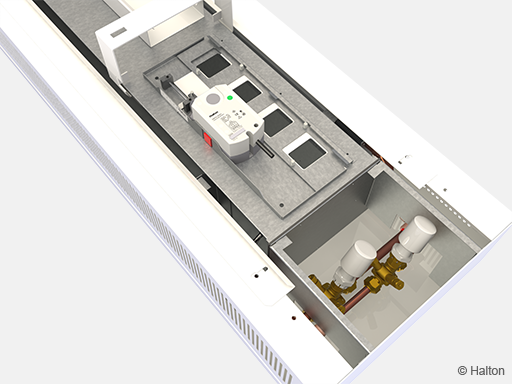
Fig.6. Standard location for valves (factory fitted)
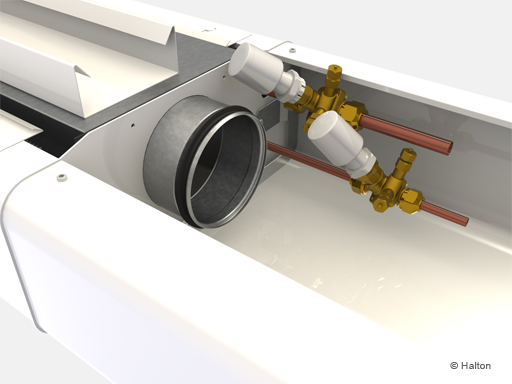
Fig.7. Alternative location for valves (inside a duct cover)
Cable tray
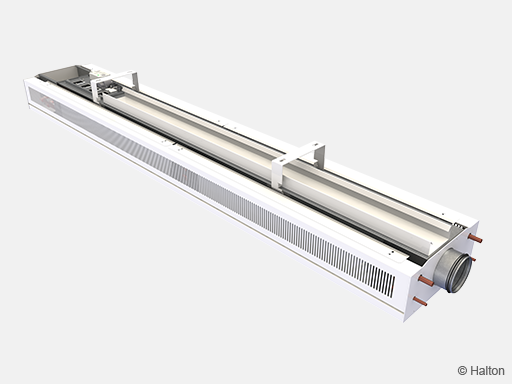
Fig.8. Cable tray in position
Duct cover
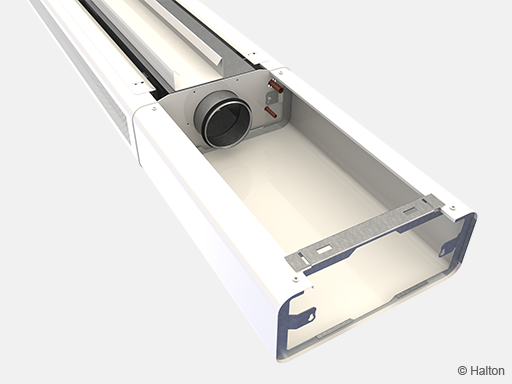
Fig.9. Duct cover assembled to beam
Function
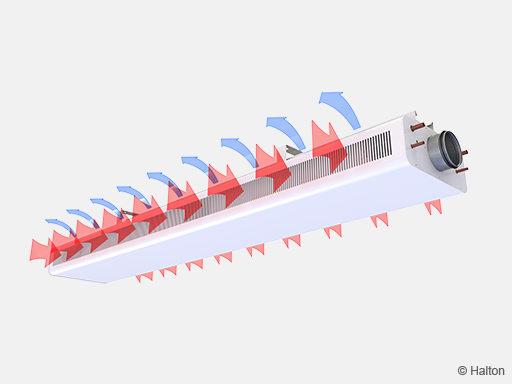
The Halton Rex Exposed unit is an active chilled beam for exposed installation.
The primary supply air enters the plenum of the active chilled beam, from which it is diffused into the room through nozzles and supply slots on the top of the beam. The supply air nozzle jets efficiently induce ambient room air through the heat exchanger, where it is either cooled or heated. The supply air jet is directed horizontally along the ceiling surface. The recommended minimum distance is 600 mm from the wall and 100 mm from the ceiling.
Supply air can be additionally discharged upwards towards the ceiling via the diffuser of Halton Air Quality control located on the top at the rear end of the chilled beam.
Velocity control in the occupied zone
Halton Velocity Control (HVC) is used for adjusting room air velocity conditions either when room layout is changed (e.g., in cases where the chilled beam is located near the partition wall) or when local, individual velocity conditions need to be altered. Halton velocity control adjustment has an impact on the induced room airflow through the heat exchanger, and therefore it either increases or decreases both the velocities in the occupied zone and the cooling/heating capacity of the chilled beam.
Halton Velocity Control involves manual velocity adjustment with three different positions (Fig.1. and 2.): 1 = Throttle, 2 = Normal, and 3 = Boost. The Halton velocity control system is divided into sections to enable the adjustment of conditions in different parts of the occupied zone. Depending on the length of the beam, optimal HVC damper module lengths between 500 and 1400 mm are used.
It is recommended to design the chilled beam in the normal position in order to allow both throttle and boost functions during the building s life cycle.

Pos. 1 = Throttle position Pos. 2 = Normal position Pos. 3 = Boost position
Fig.1. Halton Velocity Control (HVC) from side
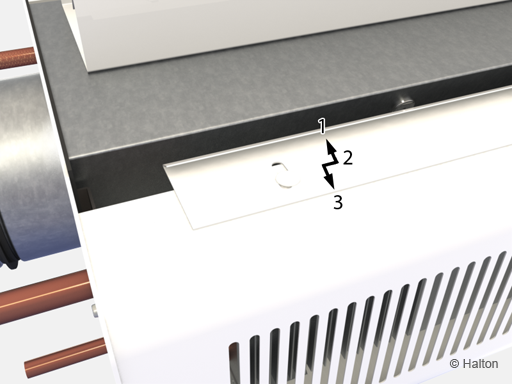
Pos. 1 = Throttle position / Pos. 2 = Normal position / Pos. 3 = Boost position
Fig.2. Halton Velocity Control (HVC) from top
Airflow adjustment and control
The supply airflow of the chilled beam nozzle jets is dependent on effective length, nozzle type and static chamber pressure, which can be adjusted e.g. by using an airflow adjustment damper (e.g. Halton PTS).
Optional Halton Air Quality (HAQ) control is used for adjusting and/or controlling additional supply airflow rate in a room space. The airflow is dependent on the opening position of the control damper and the static chamber pressure.
Halton Air Quality (HAQ)
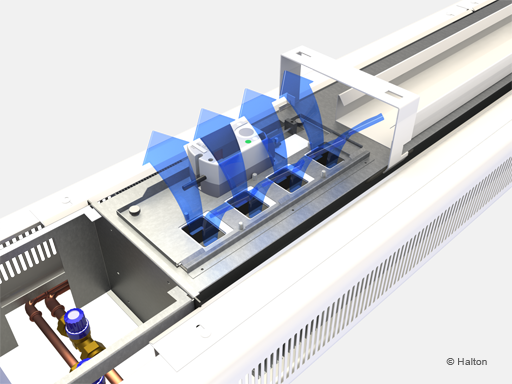
Fig.3. Motorised control damper (HAQ)
Airflow rate control is needed when either room layout or the use of the space is changed (e.g., in a change from office to meeting room). Airflow rate can be adjusted either manually or via automatic demand-based control via a motorised control damper (Fig.3.). The actuator can be controlled by a room controller (not included) using a 0-10-VDC control signal.
A chilled beam equipped with HAQ manual airflow rate adjustment can be retrofitted into motorised demand-based control simply by replacing the HAQ-unit model and connecting the power supply and control signal from a room controller to the actuator.
The chilled beams are recommended to be connected to constant pressure ductwork zone, when
- the HAQ adjustment has no impact on nozzle jet airflow
- the HAQ adjustment has no impact on either the coil cooling or heating capacities
- the HAQ airflow control has not significant impact to ductwork pressure conditions and respectively to airflow rates of other chilled beams in the same ductwork zone.
Demand-based air quality control and room air temperature control can be realised separately.
The appearance of different units – with constant, adjustable, or variable airflow – is identical.
The Halton Air Quality control unit s position and the selection of the chilled beam nozzle size allow adjustment of the primary airflow rate in the space. Airflow adjustment damper (e.g. Halton PTS) can be used for balancing the airflow.
When a motorised air quality control (HAQ) unit is used, the maximum and minimum airflow rates are adjusted with the stroke limiters of the damper. The airflow adjustment damper (e.g. Halton PTS) is not recommended for use in balancing the airflow in this case.
Five different nozzle sizes are available, to enable attaining the minimum supply airflow rate of the chilled beam in a typical room module. Typically, units that are similar (in length or nozzle type) allow effective commissioning of the system.
The primary airflow rate of each beam is adjusted using the Halton Air Quality control unit during the installation and commissioning. There is no need to change or plug nozzles of the chilled beam.
Halton Air Quality control also allows increasing the airflow rate of a chilled beam e.g., to meet the ventilation requirements of meeting rooms (up to 4 l/s per m², below 35 dB(A)).
Controlling of the airflow can be based on CO2 level. Alternatively, both air and water flow can be controlled based on temperature in two sequences. In that case the air flow rate will be modulated in the first sequence, and if the temperature exceeds the chosen set point, water valve will start to open.
Cooling and heating capacity control
The chilled beam can be equipped in the factory with either a adjustable kv control valve (RA-C) or a pressure independent valve (AB-QM). AB-QM has an adjustable maximum limit for the water flow rate and there is a pressure difference measurement for ensuring that the pressure difference (min. 16 kPa) is sufficient for proper operation. Both control valves can be equipped with a thermal on/off-actuator. See the section Accessories for further information.
In heating mode, it is recommended that the temperature difference between the jet outlet and room air would not be greater than 3 °C. The inlet water temperature of the heat exchanger should not be higher than 35 °C. Optimal heating performance requires an appropriate primary air flow rate. Thus, the air handling unit shall be in operation during heating periods to ensure proper heating performance.
System package
Halton Workplace WRA room automation system package for Halton Rex Exposed (REE) chilled beam
Halton Workplace WRA is part of the Halton Workplace solution offering.
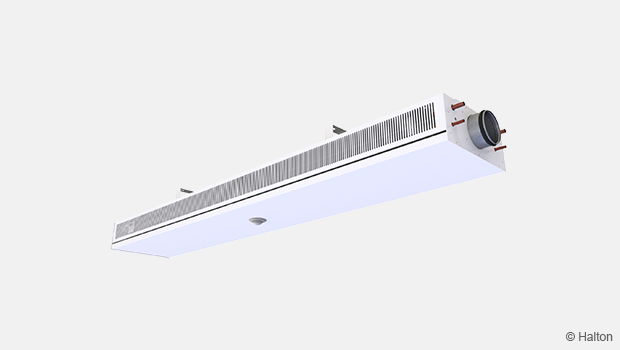
Fig. 1: Halton Workplace WRA room automation controller integrated to Halton Rex Exposed (REE) chilled beam
Halton Workplace WRA is a controller especially designed for controlling the automation system of office spaces and meeting rooms. It is used for controlling the ventilation airflow, room temperature, and indoor air quality.
The Halton Workplace WRA room automation package consists of a controller unit and optional components depending on customer needs: a wall panel and sensors for temperature, CO2, occupancy, pressure, and condensation.
There are options available for the controller unit and wall panel, depending on the number of controls and sensors required. The Halton Workplace WRA room automation controller is always combined with other Halton products for adaptable and high-level indoor climate.
Application area
- Controlling the ventilation airflow, room temperature, and indoor air quality in office spaces and meeting rooms
- The Halton Workplace WRA room automation controller is an important part of the Halton Workplace system, controlling room units and airflow control dampers
- Overall Halton Workplace System includes:
- Room air conditioning applications with Halton Workplace WRA room automation controller:
- Active chilled beams
- Exhaust units
- VAV dampers
- Active VAV diffusers
- Room air conditioning applications with Halton Workplace WRA room automation controller:
- Halton Max MDC zone control dampers
- Halton Workplace WSO system optimiser
Key features
- Factory-tested controller and wiring, easy to install
- Pre-installed project-specific parameters, quick to commission
- Several operating modes based on occupancy, thermal comfort, and indoor air quality
- Enables fully flexible layout solutions for changing needs in office environments
- Highly energy-efficient and reliable system operation
Operating principle
The Halton Workplace WRA room automation controller operates with Variable Air Volume (VAV) dampers and active chilled beams of the Halton Workplace system. These are used for adjusting the ventilation airflow, room temperature, and indoor air quality in office spaces.
Each room unit in an office space can have its own dedicated Halton Workplace WRA room automation controller, or a single controller can control multiple room units. The Halton Workplace WRA room automation controller can automatically adjust the system according to the indoor environment level preferred by users. Each room unit having its own dedicated controller brings maximum flexibility.
Room automation: Halton Rex Exposed (REE) active chilled beams with HAQ control and PTS damper, controlled with Halton Workplace WRA room automation controllers
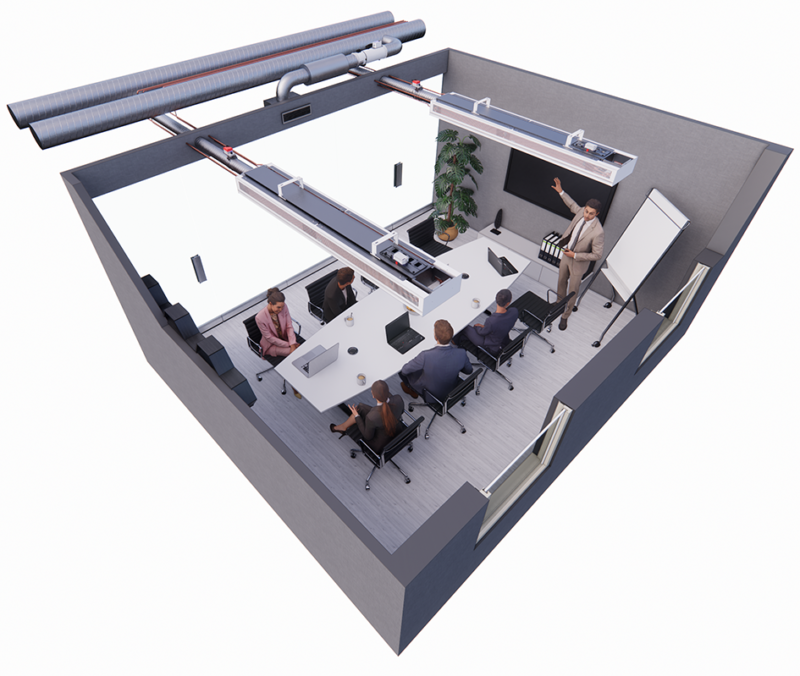
Fig. 12: Halton Rex Exposed (REE) active chilled beams with HAQ control and PTS damper, controlled with Halton Workplace WRA room automation controllers in a meeting room
Room automation description
In this configuration, two Halton Workplace WRA room automation controllers (type DXR2.E18-102A) control two Halton Rex Exposed (REE) active chilled beams. Each chilled beam has heating and cooling valves, motorised Halton Air Quality (HAQ) control, as well as integrated CO2, occupancy, pressure, and condensation sensors. A Halton PTS single-blade damper is used for controlling the minimum operating mode. The system also includes an exhaust VAV damper, window switch control, and a wall panel (type QMX3.P37) with a temperature sensor and display. One Halton Workplace WRA room automation controller can individually control up to four terminal units, and there can be several Halton Workplace Room Automation controllers in the room.
Design criteria for room automation
• Chilled beam has heating and cooling valves
• Chilled beam has motorised HAQ control
• Chilled beam has integrated CO2, occupancy, pressure, and condensation sensors
• Wall panel with temperature sensor and display
• Window switch control
• PTS damper for controlling minimum airflow
• Exhaust airflow control
Schematic drawing

Fig. 13: Schematic drawing: Halton Rex Exposed (REE) chilled beam (4-pipe) controlled with Halton Workplace WRA room automation controller
Equipment list
| Code | Equipment |
| RC | Controller unit |
| FG | Airflow damper actuator |
| FC | Airflow measurement |
| H | Water valve actuator |
| CS | Condensation sensor |
| OS | Occupancy sensor |
| PE | Pressure sensor |
| CO2 | CO2 sensor |
| WP | Wall panel |
| TE | Temperature sensor |
| TI | Temperature display |
| WS | Window switch control |
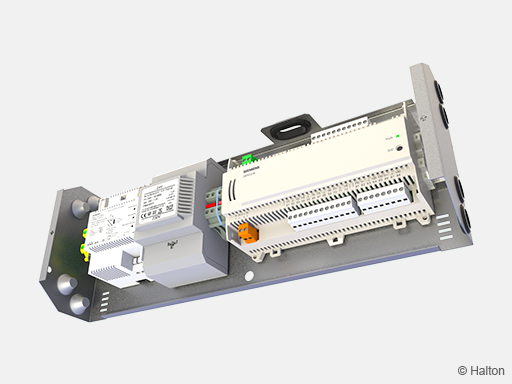
Fig. 14: Factory-installed Halton Workplace WRA room automation controller, type DXR2.E18-102A
Wiring diagram
For the wiring diagram of similar configuration, see Halton Workplace WRA room automation controller HIT page.
Components and order code examples for the system
- 2 x Active chilled beam: Halton Rex Exposed (REE)
REE/A-2800-2500, TC=H, CT=S, AQ=MO, VA=RR, CO=SW, CV=DA2, ZT=N - 1 x Exhaust unit: Halton AGC Exhaust grille + Halton PRL Plenum for grilles
AGC/N-400-100 FS=CL, ME=A, FI=PN, CO=W, ZT=N+PRL/F-400-100-160 - 1 x VAV damper: Halton Max Ultra Circular (MUC) or Halton Max One Circular (MOC)
MUC/G-160, MA=CS - 2 x standby, shut-off damper: Halton PTS
Note: Further information can be found on Halton Workplace room automation controller product page. See link below:
Cooling and heating water valve selection in Halton Workplace WRA room automation system package
Water valve selection is done in Halton Workplace WRA room automation system package. Water valve sizing depends on the number of secondary and primary chilled beam units that are controlled with single controller. One water valve is used to control the whole chilled beam group cooling or heating operated by one room controller. Water valve is sized for whole group when there are multiple chilled beams controlled with single controller unit. There can be one primary chilled beam with room controller and up to three secondary chilled beams. Water valve sizing for 1-4 chilled beams is shown below.
| Number of chilled beams (pcs.) | Water valve type | Size for cooling (DN) | Size for heating (DN) | Installation |
| 1 | ABQM | DN15 | DN15 | Integrated to chilled beam |
| 2 | ABQM | DN20 | DN15 | Loose |
| 3 | ABQM | DN20 | DN15 | Loose |
| 4 | ABQM | DN25 | DN15 | Loose |
| Number of chilled beams (pcs.) | Water valve type | Size for cooling (DN) | Size for heating (DN) | Installation |
| 1 | VPP46.. | DN15 | DN15 | Loose |
| 2 | VPP46.. | DN20 | DN15 | Loose |
| 3 | VPP46.. | DN20 | DN15 | Loose |
| 4 | VPP46.. | DN25 | DN15 | Loose |
Installation
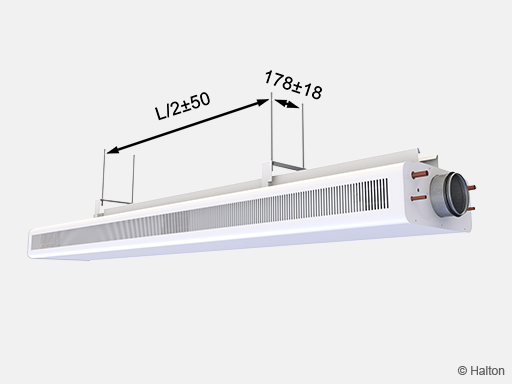
The Halton Rex Exposed unit is suitable for exposed installation in the ceiling, typically lengthwise in the room. It is recommended to position the beam no closer than 600 mm from the wall and 100 mm from the ceiling. The chilled beam ceiling brackets can be fixed directly to the ceiling surface or suspended using threaded drop rods (8 mm). It is recommended that the brackets are positioned one quarter of a unit length (L/4) away from the end of the beam.
Install the main pipelines of the cooling and heating water loops above the level of the chilled beams to enable venting of the pipework.
Connection of the motorised air quality control (HAQ):
Power supply 24 VAC
Control signal 0 … 10 VDC
Installation with brackets
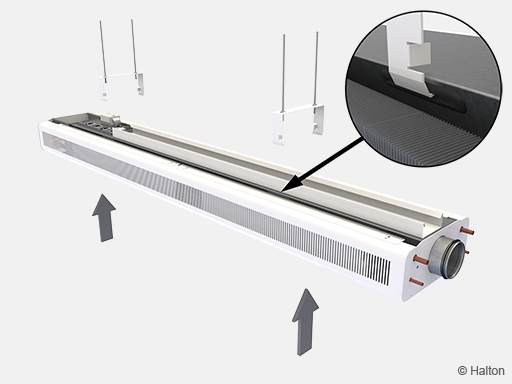
Fig.1. Fixing of the beams done by pushing the beam to the ceiling brackets.
Secure all fixing points so that they are properly locked to the fixing slots.
Installation of the duct cover
When the length of the duct cover is under 600 mm it can be installed hanging only to the Halton Rex Exposed chilled beam (Fig.3.). Longer duct covers need to be supported either from the wall (Fig.4.) or with threaded rods from the ceiling (Fig.5.).
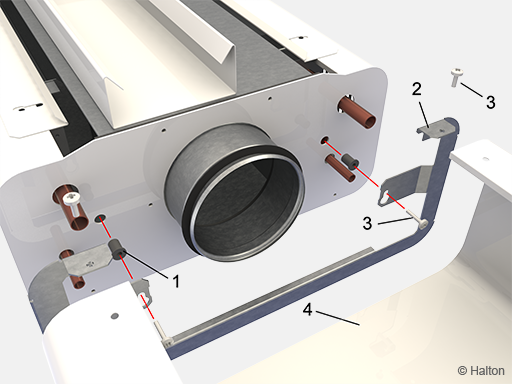
Fig.2. Fixing of the duct cover
Key:
1. Rivet nut (2 pcs)
2. Fixing plate
3. Screw (4 pcs)
4. Duct cover
When fixing the duct cover:
Push first two rivet nuts (1) to the holes at the endplate
Fix the screws loose (3/2 pcs) to the rubber nuts.
Slide the fixing plate to right position
Tighten the screws (3)
Install the duct cover (4) and fix the screws (3/2 pcs)
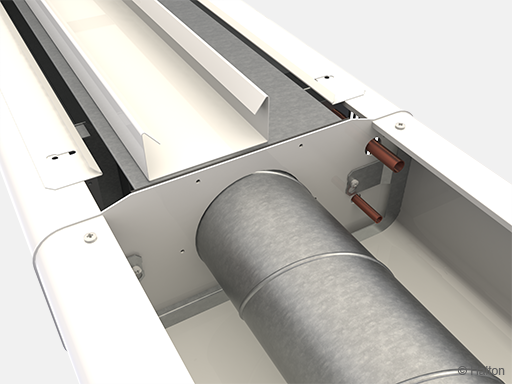
Fig.3. Duct cover fixed to the Halton Rex Exposed
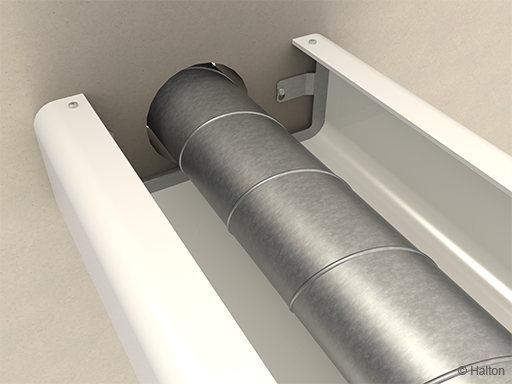
Fig.4. Duct cover fixed to the wall
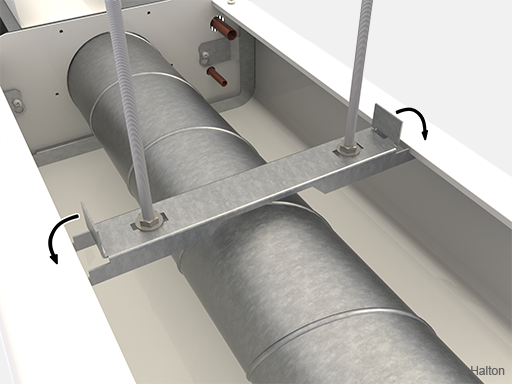
Fig.5. Duct cover fixation with threaded rods from ceiling.
After the ceiling bracket is on its place the cover plate can be locked to the right
position by bending the fixing part as shown above (arrows).
Adjustment
Cooling
The recommended cooling water mass flow rate is 0.02 … 0.10 kg/s, resulting in a temperature rise of 1 … 4 °C in the heat exchanger. To avoid condensation, the recommended inlet water temperature of the heat exchanger is 14 … 16 °C.
Heating
The recommended heating water mass flow rate is 0.01 … 0.04 kg/s, resulting in a temperature drop of 5 … 15 °C in the heat exchanger. The maximum recommended temperature of the inlet water for the heat exchanger is 35 … 45 °C.
Balancing and control of water flow rates
Balance the water flow rates of the Halton Rex Exposed chilled beam with the RA-C control valve by selecting the designed kv value in the valve body.
When using an automatically balancing combination valve AB-QM, set the designed water flow rate in the valve body and verify the pressure difference (min.7.5 kPa) between the measurement nipples of the valve. The pressure difference over the valve must be 16 kPa, to ensure proper operation.
The cooling and heating capacity of the chilled beam are controlled by regulating the water mass flow rate.
Adjustment of supply airflow rate
Each Halton Rex Exposed chilled beam is equipped with a measurement tap for static pressure measurement, which enables fast and accurate measurement of the supply airflow rate through the effective part of the beam. The airflow rate is calculated using the formulas below:
Total airflow rate (qv)

qv Total airflow rate, l/s or m3/h
qv1 Nozzle jet airflow rate, l/s or m3/h
qv2 Air quality control diffuser airflow rate, l/s or m3/h
Nozzle jet airflow rate (qv1)

l eff Length of the coil [m]
Δpm Measured static chamber pressure [Pa]
| Nozzle | k (l/s) | k (m3/h) |
| A | 0.71 | 2.56 |
| B | 0,99 | 3,56 |
| C | 1,36 | 4,90 |
| D | 2.09 | 7,52 |
| E | 3,33 | 11,99 |
The supply airflow rate of the Halton Air Quality control unit is determined by measuring Halton Rex Exposed chilled beam static pressure and reading the opening position of the HAQ unit. The airflow rate is calculated using the formula below.
Air quality control diffuser airflow rate (qv2)

a HAQ position
Δpm Measured static chamber pressure [Pa]
| k (l/s) | k (m3/h) |
| 0.17 | 0.61 |
Adjustment of the airflow in constant airflow applications
Manual Halton Air Quality (HAQ)
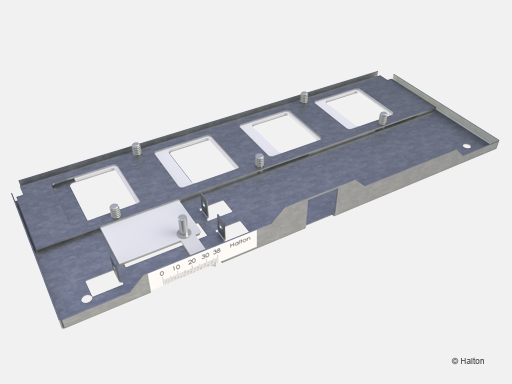
Define the position of HAQ in millimetres that correspond to airflow rate at the actual chamber pressure level.
Adjustment of HAQ is done manually with the help of position scale by adjusting the opening of the unit. It is possible to verify the opening in millimetres on the position scale.
In order to ensure accurate adjustment it is recommended to adjust HAQ-position and in the same time read the targeted chamber pressure using a manometer.
Adjustment of the airflow range in variable airflow applications
Motorised Halton Air Quality (HAQ)
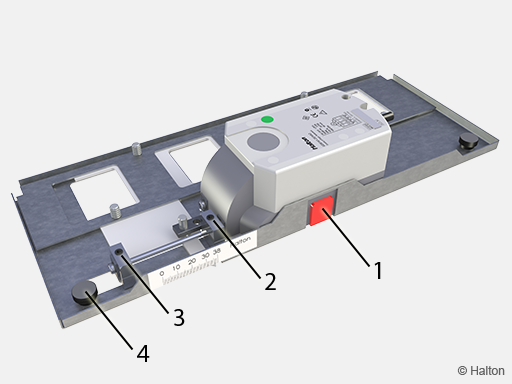
Key
1. Release of the actuator
2. Restriction of the max. opening
3. Restriction of the min. opening
4. Knurled head screw (2 pcs)
Switch-off the power supply of the actuator.
Disengage the actuator gear into manual override position by releasing the knob.
Define the maximum and minimum positions, in millimetres that correspond to maximum and minimum airflow rates at the actual chamber pressure level.
The maximum and minimum positions are adjusted with two hexagonal socket set screws (see image above, points 2 and 3). It is possible to verify the opening in millimetres on the position scale.
Switch on the power supply (24 VAC) of the actuator. The actuator calibrates the min. and max. positions automatically according to the set limits.
The actuator can be controlled from this point on by using a 0…10VDC control signal. (0 VDC = min.position, 10 VDC = max. position).
Servicing
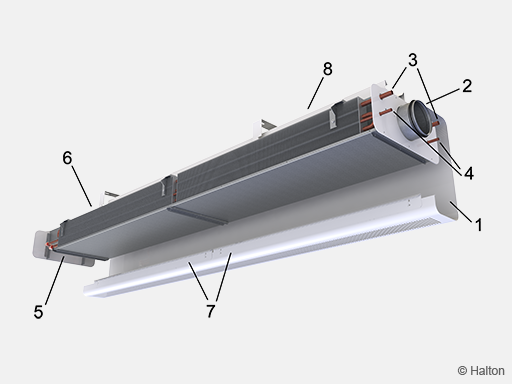
Key
1. Front panel
2. Supply air connection
3. Chilled water pipe connections
4. Heating water pipe connections
5. Control valves and actuators
6. Halton Air Quality control (HAQ)
7. Halton Velocity control (HVC)
8. Cable tray
Open the front panel of Halton Rex Exposed. In beams longer than 2400 mm, the front panel can be opened in two sections.
Clean the supply air plenum, duct, and finned coils of the heat exchanger using a vacuum cleaner, taking care not to damage the finned coils. Clean the front panel and, if necessary, the side plates with a damp cloth.
Open the access panel, and check at regular intervals that the airflow adjustment damper (if applicable) and water flow control valves are working.
The air quality control (HAQ) damper actuator can be accessed from on top of the chilled beam for service, if required.
Specification
The unit is an active chilled beam for exposed installation with bi-directional air supply.
The front panel is openable and detachable from either side without any special tools.
The chilled beam is 414 mm wide and 182 mm high, with inlet duct diameter of 125 mm.
The chilled beam can be equipped with a duct cover to cover the connection duct and pipe installations (optional).
The front panel and side panels are made of pre-painted galvanised steel plate (white, RAL 9003 or RAL 9010).
All visible parts can be painted with special colours (RAL xxxx).
The primary airflow rate is adjustable over a wide range via a separate supply air unit of the chilled beam. Adjustment of the airflow rate does not have any effect on induced airflow rate through the coil. The induced room airflow rate is manually adjustable to three positions without influencing the primary air supply flow rate.
Supply airflow rate is manually adjustable using an airflow damper, or equipped with an actuator for demand-based control of the airflow (optional).
Control of supply airflow rate does not have any effect on coil cooling and heating capacities.
The adjustable airflow rate beam has only one duct connection.
The appearance of the chilled beams with constant airflow and adjustable airflow rate is the same.
The chilled beam can be equipped with a cable tray (optional).
All pipes are manufactured from copper, connection pipes with a wall thickness of 0.9-1.0 mm. The cooling heat exchanger consists of six 15 mm pipes connected in series. The fins of the heat exchanger are manufactured from aluminium. Heating is incorporated within the heat exchanger via two 10 mm pipes connected in series. All joints are factory pressure-tested.
The maximum operating pressure of the pipework is 1.0 MPa @ 70 °C.
Each chilled beam is protected by removable plastic coating. Duct connection and pipe ends are sealed for transit.
Each chilled beam is identifiable by a serial number printed on a label attached to the chilled beam.
Order code
REE/S-L-C, SP-TC-CT-AQ-VA-CO-CV-AC-ZT
S = Nozzle type
A Nozzle 1
B Nozzle 2
C Nozzle 3
D Nozzle 4
E Nozzle 5
L = Total length of beam (mm)
1200,+100, …, 4800
C = Effective length (coil/mm)
900, +100, …, 4500
Other options and accessories
SP = System package
N No
Y Yes
TC = Cooling/heating functions (coil type)
C Cooling
H Cooling and heating
CV Cooling, with venting valves
HV Cooling and heating, with venting valves
CT = Connection type (air and water)
S Air and water connections at the same end
O Water connections at the opposite end
AQ = Air quality control (HAQ)
MA Manual (CAV)
MO Motorised (VAV)
RE Retrofit possibility
VA = Visual appearance
RO Rounded, oval perforation
RR Rounded, round perforation
AO Angular, oval perforation
AR Angular, round perforation
SO Square with fixed front panel, oval perforation
CO = Colour
SW Signal white (RAL 9003)
W Pure white (RAL 9010)
X Special colour (RAL xxxx)
CV = Control valves and actuators
NA Not assigned
DR1 RA-C, no actuator
DR2 RA-C, actuator TWA-A 24 V, NC
DR3 RA-C, actuator TWA-A 230 V, NC
DA1 AB-QM, no actuator
DA2 AB-QM, actuator TWA-Z 24 V, NC
DA3 AB-QM, actuator TWA-Z 230 V, NC
AC = Accessories
KH Cable tray
ZT = Tailored product
N No
Y Yes (ETO)
Sub-products
DCB Duct cover
Code example
REE/A-2400-2100, SP=N, TC=C, CT=S, AQ=MA, VA=RR, CO=SW, CV=DR2, AC=KH, ZT=N
Downloads
-
Halton Rex REE – Chilled beam
Data
en
-
Halton Rex REE – Ilmastointipalkki
Data
fi
-
Halton Rex REE – Poutre climatique
Data
fr
-
Halton Rex REE – Kylbaffel
Data
se
-
Halton Rex REE – Fiche technique
Data
fr_FR -
Eurovent Certification for Chilled Beams
Data
English (en) -
Enviromental Product Declaration (EPD) – Halton chilled beams, VAV type
Data
English (en)
